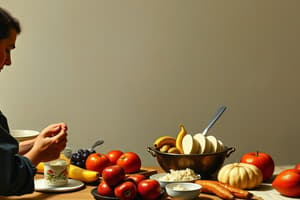Podcast
Questions and Answers
What is contamination?
What is contamination?
- A state of being impure or unfit for use (correct)
- A method of food preservation
- A type of food ingredient
- A state of being pure
Name the three types of food contamination.
Name the three types of food contamination.
Physical, chemical, microbial
What does physical contamination include?
What does physical contamination include?
Metal filings, broken glass, rodent droppings, insects, and packaging materials
Physical contamination can occur at any point in food growth or production.
Physical contamination can occur at any point in food growth or production.
What is chemical contamination?
What is chemical contamination?
List some toxic substances that may get into water supplies.
List some toxic substances that may get into water supplies.
Define food spoilage.
Define food spoilage.
What are microbial contaminants?
What are microbial contaminants?
What are the types of foodborne illness?
What are the types of foodborne illness?
An outbreak of foodborne illness requires at least three people to be affected.
An outbreak of foodborne illness requires at least three people to be affected.
How do pathogens typically cause illness?
How do pathogens typically cause illness?
What defines foodborne intoxication?
What defines foodborne intoxication?
Name some hazards that can be present in food.
Name some hazards that can be present in food.
What is a Gram-positive bacterium characterized by?
What is a Gram-positive bacterium characterized by?
Where is Staphylococcus aureus typically found?
Where is Staphylococcus aureus typically found?
Infants up to 12 months should not be fed honey.
Infants up to 12 months should not be fed honey.
What are the symptoms of foodborne illness from S. aureus?
What are the symptoms of foodborne illness from S. aureus?
What kind of bacteria is Escherichia coli?
What kind of bacteria is Escherichia coli?
Match the following foodborne contaminants with their corresponding illnesses:
Match the following foodborne contaminants with their corresponding illnesses:
What is a HACCP system?
What is a HACCP system?
Which of the following methods can prevent pathogen transmission?
Which of the following methods can prevent pathogen transmission?
Flashcards are hidden until you start studying
Study Notes
Food Safety: Sources of Contamination
- Contamination: Refers to the presence of undesirable substances that make food unfit for consumption, often introduced during various stages of food production.
Types of Food Contamination
- Three primary types: Physical, Chemical, and Microbial.
Physical Contamination
- Involves nonliving substances (e.g., metal filings, glass, rodent droppings) unintentionally introduced into food.
- Can occur at any stage of food production, presenting health hazards.
Chemical Contamination
- Can occur from pesticide residues on food; USDA monitors and tests for health risks.
- Toxic substances such as mercury, cadmium, and lead can enter water supplies.
Microbial Contaminants
- Microbes and enzymes contribute significantly to food spoilage.
Foodborne Illness
- Caused by pathogens, toxins, bacteria, parasites, and viruses, leading to symptoms such as nausea and diarrhea.
- An outbreak is defined as two or more individuals falling ill from the same contaminated food source.
Pathogenic Mechanisms
- Intoxication: Illness caused by toxins produced by microbes.
- Infection: Illness caused by microbes damaging body tissues via digestive enzymes.
Common Pathogens
-
Staphylococcus aureus:
- Gram-positive bacterium associated with foodborne illnesses.
- Found in various foods, including meats and pastries, and produces a heat-resistant toxin.
-
Clostridium botulinum:
- Dangerous anaerobic bacteria causing botulism, which leads to paralysis.
- Found in soil and improperly processed foods; spores are resistant to heat.
-
Escherichia coli:
- Gram-negative bacteria from the intestines of mammals, often contaminating food from infected handlers.
- Symptoms can be severe, leading to vomiting and diarrhea.
-
Listeria monocytogenes:
- Can multiply in refrigeration and is particularly dangerous to high-risk groups like pregnant women.
- Found in soft cheeses, unwashed vegetables, and raw meats.
-
Salmonella:
- Found in eggs, poultry, and meat, causing salmonellosis with serious gastroenteritis symptoms.
Parasites
- Include organisms like Trichinella spiralis, which can be transmitted through undercooked meat, particularly from hogs and wild game.
Viruses
- Microscopic agents that do not multiply in food but can cause illness through fecal-oral transmission.
- Notable viruses include Rotavirus, Norovirus, and Hepatitis A.
Pathogen Transmission
- Can occur through animal feces contaminating food or improper handling.
- Danger Zone: Temperature range (5-57°C or 41-135°F) where pathogens multiply rapidly.
Prevention Strategies
- Proper hygiene practices are critical for food handlers.
- Cross-contamination prevention through thorough cleaning of surfaces and tools.
- HACCP (Hazard Analysis and Critical Control Point): A systematic approach to food safety that identifies and mitigates contamination risks at critical points.
HACCP Principles
- Conduct a hazard analysis, identify critical control points, establish limits, monitor procedures, take corrective actions, verify systems, and maintain documentation.
Summary
- Food safety relies on understanding contamination types, recognizing pathogens, preventing transmission, and implementing structured food safety systems like HACCP to minimize risks and protect public health.
Studying That Suits You
Use AI to generate personalized quizzes and flashcards to suit your learning preferences.




